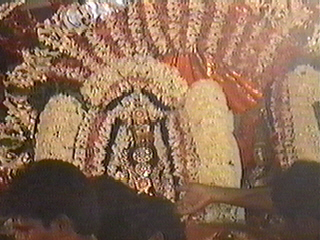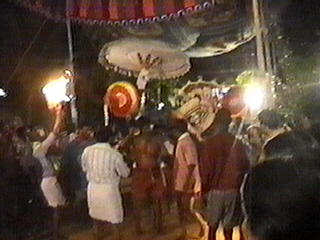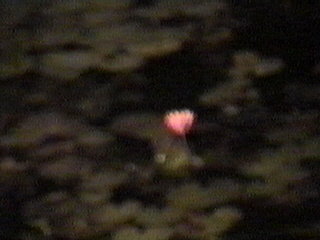275 Saivite Temples of India from the 7th-9th century AD
Abodes of Shiva - HomeTemplenet Archives
The Templenet Encyclopedia
Indian Temple Architecture Travel and
Tourism Links
Festivals and Fairs
Beliefs & Legends
Glossary of Terms
 The
Ultimate Source of Information on Indian Temples The
Ultimate Source of Information on Indian Temples
©1996 K. Kannikeswaran
No part of this site may be
reproduced or used in any form without the author's permission.
Related links
Tamilnadu Tourism
District Map of
Tamilnadu
For more information please contact:
webmaster@templenet.com
All Rights Reserved
Templenet
where
Tradition Meets Technology
|

Marundeeswarar Temple at
Chennai (Tiruvanmyur)
(Paadal Petra Stalam)
Special Feature - 1998
Significance: This ancient temple located in the southern
fringe of the sprawling city of Chennai dates back to the past millennium when
it was visited and sung by two of the Saivite Saints - Nayanmars Appar and Sambandar
. Marundeeswarar or the The Divine Physician Shiva is the presiding deity here.
Tiruvanmyur is said to abound in medicinal herbs. This deity is said to have been
worshipped by Valmiki the author of the epic Ramayanam. The place itself owes its name to
this sage poet. This shrine also enshrines Tyagarajar as in Tiruvotriyur. sprawling city of Chennai dates back to the past millennium when
it was visited and sung by two of the Saivite Saints - Nayanmars Appar and Sambandar
. Marundeeswarar or the The Divine Physician Shiva is the presiding deity here.
Tiruvanmyur is said to abound in medicinal herbs. This deity is said to have been
worshipped by Valmiki the author of the epic Ramayanam. The place itself owes its name to
this sage poet. This shrine also enshrines Tyagarajar as in Tiruvotriyur.
Architecture: The temple itself occupies an area of about
one acre. The presiding deity faces the west. Two beautiful five tiered towers or Raja
Gopurams grace the Eastern and the Western entrances to the temple. The main temple
consists of two separate spacious chambers, the Thyagaraja Mandapam and the Marundeeswarar
Mandapam. Thirty six massive pillars endowed with elegant carvings adorn the Thyagaraja
Mandapam which houses the Somaskanda Swaroopam of Shiva. Tripurasundari the consort of the
presiding deity is housed in a separate mandapam in the temple complex. Numerous images
adorn the pillars of the temple, while stucco figures grace the Gopurams or the entrance
towers.
Antiquity: Tirugnanasambandar and Tirunavukkarasar the Saint Saivite
Poets have visited and sung the praises of this temple, testifying its existence during
their life time - about a 1200 years ago. Arunagirinathar has visited this temple and has
sung praises of Subramanya here. Stone inscriptions dating back to the 11th century AD are
found in abundance in this temple. Stone inscriptions in other temples in Chennai namely
Kapaleeswarar Temple, Virupaksheeswarar Temple etc. refer to Tiruvanmiyur. This temple
held an exalted position for centuries and it gradually fell in repair. Renovative work
was carried on earlier in this century culminating in a consecration ceremony in 1913.
Further renovative work was done in the late 70s.
Deities: Marundeeswara is worshipped in the form of a 1 and a half
feet high Shiva Lingam said to have manifested by itself. This deity is referred to as
Marundeeswara or Aushadeeswara for having performed the act of introducing the
mythological sage Agastyar into the mysteries of herbal medicine. Shiva is said to have
blessed the Poet Sage Valmiki here and hence the name Valmikanathar. There is also a
grand mandapam enshrining Tyagarajar - the festival image here. The Goddess Tripurasundari
or Chokkanayaki is housed in a separate temple. Vijayaganapati and Subramanya have
separate Mandapams smaller in size within the temple complex. Inside the Mahamandapam
(enclosing the shrine to Marundeeswarar) are found images of the 63 Saivite Saints - the
Nayanmars, images of Ganapati and Muthukumaraswamy (Kartikeya) and an iposing image of
Nataraja with Sivakamasundari and Manikkavachakar. Also in this temple are found 108
Sivalingams and five massive Sivalingams representing the elements.
Worship: Four services are offered each day (Kalasandhi 7:30 AM, Uchi
Kaalam, 11:30, Sayaratchai 5 PM, and Ardhajamam 9 pm. The shrine is open from 6 am until
1130 AM and from 4 PM until 9 PM.
Festivals: The annual Bhramotsavam is celebrated in March - April.
Eighteen types of dances involving the festival image of Thyagaraja is a
noteworthy unique feature of this temple. The image is placed on a speciallly designed
device called Thyagarkanai and taken out on the 10th , and 11th days of the Bhramotsavam
and on Tiruvadirai in the December January months and the 18 dances are enacted. types of dances involving the festival image of Thyagaraja is a
noteworthy unique feature of this temple. The image is placed on a speciallly designed
device called Thyagarkanai and taken out on the 10th , and 11th days of the Bhramotsavam
and on Tiruvadirai in the December January months and the 18 dances are enacted.
Tyagaraja of Tiruvarur is said to have been worshipped by Mahavishnu and Indra the
King of Gods. Seven shrines associated with Tyagarajar in Tamilnadu are known as the
Sapta Vitanka stalams. Three replicas of Tyagarajar are found at Tiruvanmyur,
Tiruvotriyur and Tirukachur.
Other interesting facts: The Vanni tree is the sacred tree or Vruksham
here.Five sacred tanks or theerthams are associated with this temple -
Janmanasini, Kamanasini, Papanasini, Gnanadhayini and Mokshadhayini. Gnanadhyayini is said
to have ceased to exist. Kamanasini and Mokshadhayini are in the form of wells.
Janmanasini is in the form of the Chitrakulam tank in front of the Eastern tower entrance,
whilethe Papanasini is the massive tank situated a little away from the same tower. sacred tanks or theerthams are associated with this temple -
Janmanasini, Kamanasini, Papanasini, Gnanadhayini and Mokshadhayini. Gnanadhyayini is said
to have ceased to exist. Kamanasini and Mokshadhayini are in the form of wells.
Janmanasini is in the form of the Chitrakulam tank in front of the Eastern tower entrance,
whilethe Papanasini is the massive tank situated a little away from the same tower.
Access and Accomodation: Tiruvanmyur is located in Chennai the capital
of Tamilnadu.
[Temples of Tamilnadu][The Templenet Encyclopedia -
Index to States]
|

 sprawling city of Chennai dates back to the past millennium when
it was visited and sung by two of the Saivite Saints - Nayanmars Appar and Sambandar
. Marundeeswarar or the The Divine Physician Shiva is the presiding deity here.
Tiruvanmyur is said to abound in medicinal herbs. This deity is said to have been
worshipped by Valmiki the author of the epic Ramayanam. The place itself owes its name to
this sage poet. This shrine also enshrines Tyagarajar as in Tiruvotriyur.
sprawling city of Chennai dates back to the past millennium when
it was visited and sung by two of the Saivite Saints - Nayanmars Appar and Sambandar
. Marundeeswarar or the The Divine Physician Shiva is the presiding deity here.
Tiruvanmyur is said to abound in medicinal herbs. This deity is said to have been
worshipped by Valmiki the author of the epic Ramayanam. The place itself owes its name to
this sage poet. This shrine also enshrines Tyagarajar as in Tiruvotriyur. types of dances involving the festival image of Thyagaraja is a
noteworthy unique feature of this temple. The image is placed on a speciallly designed
device called Thyagarkanai and taken out on the 10th , and 11th days of the Bhramotsavam
and on Tiruvadirai in the December January months and the 18 dances are enacted.
types of dances involving the festival image of Thyagaraja is a
noteworthy unique feature of this temple. The image is placed on a speciallly designed
device called Thyagarkanai and taken out on the 10th , and 11th days of the Bhramotsavam
and on Tiruvadirai in the December January months and the 18 dances are enacted.  sacred tanks or theerthams are associated with this temple -
Janmanasini, Kamanasini, Papanasini, Gnanadhayini and Mokshadhayini. Gnanadhyayini is said
to have ceased to exist. Kamanasini and Mokshadhayini are in the form of wells.
Janmanasini is in the form of the Chitrakulam tank in front of the Eastern tower entrance,
whilethe Papanasini is the massive tank situated a little away from the same tower.
sacred tanks or theerthams are associated with this temple -
Janmanasini, Kamanasini, Papanasini, Gnanadhayini and Mokshadhayini. Gnanadhyayini is said
to have ceased to exist. Kamanasini and Mokshadhayini are in the form of wells.
Janmanasini is in the form of the Chitrakulam tank in front of the Eastern tower entrance,
whilethe Papanasini is the massive tank situated a little away from the same tower.